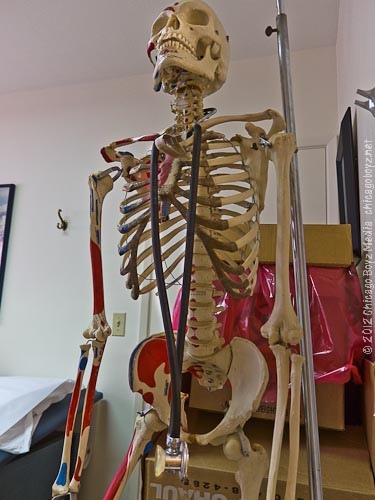
Disregard the false rumors about staff cuts under socialized medicine.

Some Chicago Boyz know each other from student days at the University of Chicago. Others are Chicago boys in spirit. The blog name is also intended as a good-humored gesture of admiration for distinguished Chicago School economists and fellow travelers.

…they may not have what you need but you can always get an apology.

The Supreme Court will rule on the constitutionality of Obamacare this year. The arguments and the issue which got the most publicity was the individual mandate. I don’t actually care much about this although it may well violate the Constitution. There are far worse things in the legislation and they should be emphatically rejected by the Supreme Court. The worst of the issues is discussed in detail here. This is a really frightening piece of legislation and I cannot imagine that the Court will let it stand. Of course, given the absence of argument, the Court will have to find this hidden provision itself.
Perhaps nothing in the Obamacare legislation embodies the top-down, command-and-control nature of Progressive healthcare more than the Independent Payment Advisory Board (IPAB), a 15-member panel of “experts” to be appointed by the President. There are three particular features of the IPAB that illustrate this fact: The IPAB will control all healthcare spending, public and private. The IPAB has been awarded near-dictatorial power. And the IPAB is designed to be a nearly immutable entity.
How is this accomplished ?
Specifically, Section 10320 (in the Managers’ Amendments portion of the legislation) grants the IPAB, beginning in 2015, the authority to limit all healthcare expenditures, that is, all healthcare expenditures, and not just expenditures by Medicare or government-run programs.
To emphasize this expanded authority, Section 10320 changes the name of the “Independent Medicare Advisory Board” to the “Independent Payment Advisory Board.” It directs the IPAB, at least every two years, to “submit to Congress and the President recommendations to slow the growth in national health expenditures” for private healthcare programs. Furthermore, it designates that these “recommendations” may be implemented by the Secretary of HHS or other Federal agencies “administratively” (that is, without any action by Congress).
Thus the federal government can control, under penalty of criminal prosecution of doctors, private health care spending ! This goes well beyond Medicare and Medicaid. It will prevent, unless stopped, people from spending their own money on health care.
That is not the worst of it. The IPAB cannot be changed or repealed by Congress. This is unprecedented in US law. Even the ill-advised Prohibition Amendment, promoted as another moral obligation by progressives after World War I, could be repealed by another constitutional amendment.
A quick reading of Section 3403 might leave one with the impression that the IPAB is a sort of Mr. Rogers of healthcare a mild-mannered, friendly, always-helpful, but ultimately undemanding agent for good. This is the impression imparted by the first few paragraphs of the Section, which paint the new entity as an “advisory” board, whose main task is to develop “proposals” and “advisory reports,” which “proposals” and “advisory reports” would solely consist of various “recommendations,” that ought to be “considered” for the purpose of cost reduction.
Nothing could be further from the truth. This language is simply another example of supplying a new law, which is far more radical than the authors would like people to know, with a soothingly misleading introductory paragraph. The IPAB is actually designed to be as all-powerful as it’s possible to be.
From a Washington Post story about Dick Cheney’s heart transplant (via Instapundit):
A study published last November found that treatment similar to what Cheney received costs $167,208 for every year of life saved. Treatments that “buy” a year of life for $50,000 or less are considered cost-effective, and those costing $50,000 to $100,000 are generally considered acceptable. (A European study in 2011 found the device much less of a bargain, at a cost of $414,275 for year of life saved).
Who gets a donor heart when one comes available depends on many variables, including body size and blood type. The most important one, however, is a person’s clinical condition and immediate availability for surgery.
There are strict guidelines for placing someone in the most urgent category and the decision is made by a team of many specialists. Moving someone to the top of the list who shouldn’t be there would be hard to do and would open a hospital to major sanctions. Both Bull and John said they are confident Cheney got no special breaks.
From the quoted passage: Treatments that “buy” a year of life for $50,000 or less are considered cost-effective, and those costing $50,000 to $100,000 are generally considered acceptable. [My italics.]
The unstated assumptions here are that 1) third parties will pay for transplants and therefore get to decide which patients will be considered to receive transplants, and 2) third parties will allocate the limited supply of transplantable organs.
When I was a medical school junior, we had a rotation on the Neurology service at LA County Hospital. One of my classmates was planning a career in neurology but the reason it was so popular with the students like me who were interested in surgery was that we got to do tracheostomies. A number of patients with severe neurological lesions would require respirators or had trouble with airway secretions requiring a tracheostomy. This was our one chance to do surgery, even a minor procedure as things go. It was good practice and I later did a lot of tracheostomies, some quite difficult and rushed.
Our resident was a very interesting guy named Dick Boggs. He was tall and looked a lot like Orson Welles did when he was young and making “The Third Man.” Boggs was quiet and aloof but let us do trachs and work up any patient we wanted to. I had some very interesting cases. One was a woman who showed all the signs of alcoholic neuropathy, which is very similar to diabetic neuropathey. It was a popular rotation for juniors. Boggs was popular among the residents and was elected the president of the Interns’ and Residents’ Association, which under his leadership took on some of the characteristics of a union.
At the time, intern and resident pay was very low and, aside from a new dormitory that was built for single house staff, we were on our own. I was married with one child, born in March 1965, so I was really on my own. My wife quit her job as a teacher in January 1965 and I was working after hours doing histories and physicals at private hospitals for $7 per hour. Fortunately, my tuition was covered by scholarship but living expenses were tight. We lived on $200/month contributed by our parents, $100 from my father and the same from Irene’s parents. Half of that went for the rent of our two bedroom house in Eagle Rock, near Pasadena. I’m spending some time on details to emphasize what Boggs accomplished for us all.